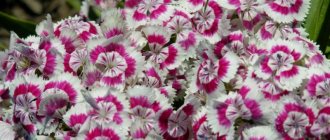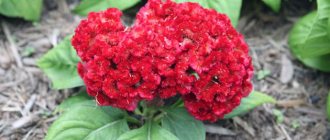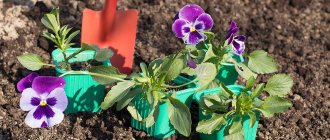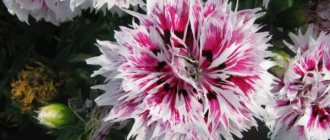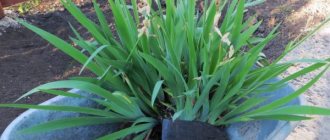The most famous varieties and varieties of plants
The magnificent herbaceous plant salpiglossis is known to many gardeners under the name “pipetongue”. It can transform any garden plot beyond recognition: make it beautiful and fragrant. Its gorgeous velvet flowers, about 6 cm in diameter, look like large bells of various shades (from yellow, white to blue), the leaves are alternate, whole or pinnately incised.
Salpiglossis has very bright flowers with a strong aroma
The plant can reach a height of 15 cm to 1 m and blooms from early summer to mid-autumn. It is an annual and perennial (biennial) species native to South America. The presented photo will convey to you all its magical beauty.
The family of this plant consists of about 20 unique species, among which there are annual and perennial salpiglossis.
Its most popular species is considered to be salpiglosis notched . Its thin stems, covered with sticky hairs, can reach up to 1 m in height. It has wavy or toothed leaves and velvety, funnel-shaped flowers with five petals. The versatility of the color of the notched salpiglossis is also pleasing to the eye. A luxurious representative of this species is shown in the following photo.
Salpiglosis notched
Most often, the following varieties of notched salpiglossis are found:
- low (its branching bushes reach only 40 cm in height, it has lush flowering);
- large-flowered (tall variety covered with large flowers);
- superbyssima (the variety is distinguished by beautiful corrugated flowers and non-branching stems).
Description of the Salpiglossis flower
This is an annual plant with an erect thin stem. Height varies from 50 to 100 cm, branching is insignificant. The shoots are evenly covered with short bristly hairs and appear sticky to the touch.
The root system is of mixed type: with a main stem and developed lateral roots.
The leaves are dark green, grow on petioles at the base of the shoots, and are oblong in shape. On the middle tiers they are short-petioled, on the upper ones they are sessile and narrow, notched-lobed. There is both a smooth edge of the leaf plate and one with teeth.
The flower is large, 4-6 cm in diameter, growing singly on a stem. It looks like a funnel of regular shape. It has 5 petals - blades. The color is varied and rich: purple, yellow, shades of red, blue. A distinctive feature is the expressive lines on the petals: gold, burgundy or scarlet shades. Each marble stripe pattern is unique and will not be repeated. The shape of the flower is similar to a bell, and the color is like an orchid. Flowering continues from mid-summer until September, in warm climates until November.
The seeds are light and formed in oval boxes. They have a long germination period of 4-5 years.
Planting and caring for salpiglossis
First of all, you should choose the right place for the plant. A shaded area that will be well protected from sharp gusts of wind is ideal. Fertile soil rich in humus can ensure rapid growth of salpiglossis.
Planting of Tubetongue in open ground begins in early May, after the end of the last night frosts. Initially, a week before planting, the ground is dug up with added ash, a small amount of peat and sand. This plant loves neutral and slightly acidic soils.
A shady place is suitable for growing salpiglossis.
In the selected area, holes are made up to 2.5 cm deep, placed at a distance of 25 cm from each other. Seeds are sown in them, lightly sprinkled with a thin layer of soil and watered with water.
Provide the plant with moderate watering. A lack of moisture will lead to a decrease in the abundance of flowering and a decrease in growth activity, and its excess can cause rotting of the plant’s root system. In the summer season, the plant requires daily watering and spraying, and in the fall and spring two or three procedures per week will be enough for it.
It is very important to follow the watering schedule
In order for salpiglossis to delight you with constant flowering, remove dried flowers from it in a timely manner. Fresh buds will soon appear in their place. Also for this purpose, clothespins are formed.
Attention! If you are growing varieties with tall, thin stems, provide them with support. This will prevent the plants from breaking.
Planting in open ground
In mid-May, a place to plant in a flower bed is chosen. The area should be moderately lit, loose, fertile. Salpiglossis prefers a sunny place, protected from the wind; in partial shade it will bloom weaker.
Step by step steps:
- In two or one and a half weeks, they dig up the soil, add ash and dolomite flour.
- Add sand, humus or peat to clay soil.
- When the temperature reaches no lower than +10 °C, dig up before planting.
- Plant the sprouts at a distance of 30 cm.
- First, the seedlings are watered, then together with the lump, they are lowered into the planting holes using the pass method and sprinkled with earth.
- Water again and install supports if necessary.
- The soil is mulched with compost.
The flower will bloom in June and will delight you with flowering until October.
Reproduction and feeding of plants with fertilizers
You can’t even imagine what tremendous pleasure the mind-blowing salpiglossis will bring you. Growing a crop from seeds can be done in two ways:
- seedlings;
- seedless.
Salpiglossis grown by seedlings will bloom faster.
The most suitable time for germinating seeds is March. Wide and shallow containers are used for planting them. Seeds should be sown individually in loose and moist soil. After this, the container with the seedlings is covered with glass and placed on a well-lit windowsill.
Advice. To make seedlings germinate faster, place a white sheet of paper on top of the glass. This way the seedlings will be provided with the necessary amount of sunlight and protected from direct sunlight.
For the first two weeks, you need to periodically ventilate the container with seedlings and remove condensation. Shoots will appear in 10-15 days. When the first leaves appear, the seedlings dive into separate cups.
Attention! Replant seedlings very carefully, as their root system is very fragile.
Pinch the tops of the sprouts several times to help them develop faster. Do not forget about moderate watering of plants. At the end of May, seedlings can already be planted in open ground. Planted salpiglossis should bloom at the end of June.
However, the seeds of the plant can be planted immediately in open ground; this is usually done in early May. But in this case, salpiglossis will show you its flowering only in the second half of summer. Its seeds are sown in loose, moistened and prepared soil, in shallow holes. They are covered with earth and watered.
Adding mineral fertilizers will benefit salpiglossis
Seed germination rate is quite high. When the sprouts reach 4 cm in height, they should be thinned out a little.
Salpiglossis responds well to the application of mineral fertilizers. Such feeding should be done about twice a week. This procedure is especially important during the flowering period of the plant. This will enrich the soil and contribute to the active development of the tubal tongue.
As you can see, the plant does not require special care; it will not take up a lot of your free time and effort.
Growing salpiglossis from seeds
How to sow seeds
Salpiglossis is propagated by seeds. With the seedling method of cultivation, salpiglossis seeds are sown in early March in wide and shallow containers filled with loose soil. Spread the seeds on the surface of the moistened substrate as little as possible, press them to the surface, cover the crops with glass or film and keep them on a light windowsill at a temperature of 15-20 ºC. To speed up seed germination and protect emerging seedlings from the bright sun, place a sheet of white paper on the film.
- Sedum – care, photos, types
Seedling care
Caring for crops involves ventilating the greenhouse and removing condensation from the film. Salpiglossis shoots will appear in 2-3 weeks, but the covering from the crops is not removed immediately: first it is removed for an hour or two, then for 3-4 hours, and when the seedlings get used to the room conditions, it will be possible to remove the glass completely.
As soon as the salpiglossis seedlings begin to form the first pair of leaves, the seedlings need to be planted into individual pots or cups. Keep in mind that the roots of seedlings are very fragile, and after picking, the seedlings take quite a long time to take root. As soon as the seedlings begin to grow, their tops begin to be pinched so that the small salpiglossis bushes better. Water the seedlings moderately, preventing the soil from drying out or becoming waterlogged.
Dangerous diseases and pests
The most dangerous pest for salpiglossis is the aphid. As soon as you notice plants damaged by it, treat them with an insecticidal composition. In addition, the danger is infection by a fungus, from which the plant begins to change its color, rot and may completely die. For prevention in this case, it is recommended to treat the soil with a fungicide.
Regularly inspect the plant for pests.
Salpiglossis: combination with other plants and use in landscape design
The attractive appearance and fairly simple care of salpiglossis could not be ignored by modern landscape designers.
The plant makes excellent combinations with salvias, petunias, cynariums and marigolds. It also looks very impressive against the background of various coniferous plants. Its azure, lilac, blue, violet, white, yellow, gold and dark brown tones will fill any flowerbed with bright colors and will cause a lot of admiring glances.
Salpiglossis in landscape design
You can see the wonderful options for using salpiglossis in landscape design in the following photos.
By planting bright salpiglossis on your site, you will fill the surrounding exterior with harmony and comfort, making it stylish, neat and well-groomed.




